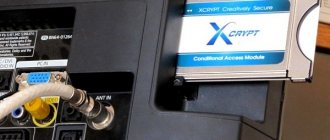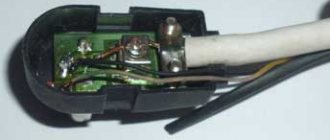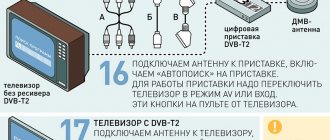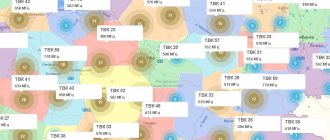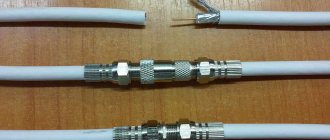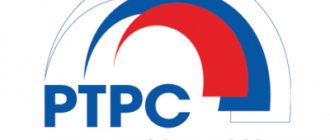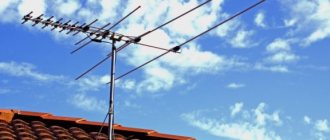The relevance of the work on building systems for collective reception of terrestrial television broadcasting signals is determined by the Federal Law “On Communications” (in terms of ensuring the integrity, stability and security of the functioning of systems and networks for supplying terrestrial digital television broadcasting signals) and the Federal Target Program “Development of Television and Radio Broadcasting in the Russian Federation for 2009 - 2021" (in terms of creating conditions to ensure that the population can receive an on-air digital television signal in "radio shadow" zones).
In 2021, the process of switching off analogue terrestrial television broadcasting ends. At the same time, thanks to the combination of digital terrestrial television, satellite, cable and IP television, as well as OTT services, almost the entire population of the Russian Federation has the technical ability to receive 20 or more television channels in digital quality.
General provisions
When introducing DTV, the most pressing issue is the development and creation of a system for receiving digital TV programs. When building this system, considerations such as ease of technical implementation and economic efficiency, minimizing the time spent on creating the system and the reliability of its elements come to the fore.
To solve the problem of providing the population of the Russian Federation with digital terrestrial television broadcasting services (especially for the population living on the borders and outside the service areas of radio signals from television transmitters or in “radio shadow” zones), considerations of creating systems for collective reception of digital programs in these territories come to the fore, distributed on regional airwaves.
In connection with the decision made on the transition of the Russian Federation to second-generation digital TV broadcasting standards [1, 2], the tasks of updating and modernizing the existing national standards for first-generation DVB systems (in terms of reflecting the specifics of the use of second-generation DVB systems) arose, as well as preparation of new national standards that apply exclusively to second-generation systems, including the DVB-T2 digital broadcasting system.
The task was set to develop a standard for collective reception systems designed for receiving radio signals from second-generation terrestrial digital television broadcasting DVB-T2 and distributing these radio signals via cable in residential and public buildings located on the borders and outside the service areas of radio signals from television transmitters or in “radio shadow” areas "
Table 1 shows fundamentally possible options for generating signals that can be distributed in a collective reception system.
| Table 1 – Options for generating a distributed signal | ||
| № | Received signal | Distributed signal |
| 1 | DVB-T2 | PAL/SECAM |
| 2 | DVB-C | |
| 3 | DVB-C2 | |
| 4 | DVB-T2* | |
| 5 | DVB-T2** | |
| * - option with the possibility of transmodulation and frequency conversion; ** - option without transmodulation and frequency conversion | ||
Option 1 (DVB-T2 → PAL/SECAM) is designed for the use of an outdated analogue receiving park; for its implementation, it requires demodulation of digital signals of the received multiplexes with subsequent analogue modulation of the signals (in this case, the number of analogue modulators must be equal to the number of channels included in the demodulated multiplexes) . This option is difficult to implement, requires large capital expenditures and does not correspond to modern digitalization trends.
Option 2 (DVB-T2 → DVB-C) is widely used in world and domestic practice; its implementation requires demodulation of DVB-T2 signals and subsequent modulation according to the DVB-C standard (in this option, the number of demodulators is equal to the number of modulators). The gain in noise immunity and flow rate that can be obtained with this conversion is not significant for solving the problem of collective cable reception with a small number of physical radio channels distributed in the network. This option is difficult to implement and requires the purchase of modems.
Option 3 (DVB-T2 → DVB-C2) requires demodulation of DVB-T2 signals and subsequent modulation according to the DVB-C2 standard for its implementation [3]. This option allows, in principle, to increase the speed of distributed streams compared to the speed of received streams. However, the gain obtained in this case is not decisive for solving the problem of collective cable reception with a small number of physical radio channels distributed in the network. In addition, it is necessary to take into account the fact that currently at the disposal of subscribers and in the retail network there are only a small number of television receivers and STB set-top boxes that support work with the DVB-C2 standard. This option is difficult to implement and requires the purchase of modems.
Option 4 ( DVB-T2 → DVB-T2 with the possibility of transmodulation and frequency conversion) requires for its implementation demodulation of DVB-T2 signals and subsequent modulation in the same standard, but with different modulation parameters. The gain in noise immunity and flow rate, which, in principle, can be obtained with this conversion, is not significant for solving the problem of collective cable reception with a small number of multiplexes.
Option 5 ( DVB-T2 → DVB-T2 without transmodulation and frequency conversion) does not require any signal conversion for its implementation, except for direct amplification and allows end-to-end transmission of received DVB-T2 signals through the distribution network. In terms of complexity of implementation, this option is the simplest and requires minimal capital costs. In addition, this option is currently widely used to implement TV reception systems in cottages and private homes.
Thus, the most preferable option for building a collective reception system in terms of implementation complexity, minimizing capital costs and solving issues of system stability is the option of end-to-end transmission of received DVB-T2 signals through the distribution network in an unchanged form (without transmodulation and frequency conversion) with the ability to receive to any DVB-T2 receivers.
Systems for collective reception of terrestrial digital television broadcasting signals must provide the ability to receive and distribute broadcast television radio signals in standard television channels in accordance with GOST 7845 in bands IV and V (470 - 862 MHz).
Depending on the complexity of the network and the number of subscribers served, collective reception systems [4] can be divided into categories in accordance with the data in Table 2.
Table 2 – Classification of collective reception systems
| System characteristics (category) * | Application area (number of users) |
| Collective reception system for one direction of distribution (category 1) | Small residential or public buildings (up to 100) |
| Large collective reception system for several distribution directions (category 2) | Large residential and public buildings, several nearby buildings (up to 5000) |
| * The classification of collective reception systems is conditional: the scope of application, system characteristics and the number of users can be changed during operation. | |
How to switch to digital and analog together?
In some regions it shows only one multipack, which includes 10 channels. In such situations, the collective antenna is not capable of providing digital broadcasting. The problem can be solved by setting up analog channels.
Setting up digital and analogue broadcasting depends on the release, configuration and model of the antenna. In practice, it was found that collective antennas allow simultaneous viewing of analogue and digital TV channels .
Having both digital and analog signals is preferred by viewers who want to watch both local and federal channels. To do this, the antenna must be able to receive signals in two bands: meter and decimeter.
To configure analog channels, you need to purchase a cable . It connects to the antenna input of a digital set-top box (or TV). If the subscriber has a set-top box, then use an additional cable to connect the device to the television receiver. Then the signal is set in analog format using the control panel.
Now you can start searching for TV channels. You can also switch to digital broadcasting using the remote control, but in AV mode.
System structure
- Collective reception systems are a set of technical means designed for the reception and distribution in residential and public buildings of digital television broadcasting radio signals of the DVB-T2 standard, coming from the output of the receiving antenna.
- The combination of receiving equipment and a linear network that ensures the reception and transmission of digital television broadcasting radio signals in a collective reception system forms a distribution network.
- The receiving equipment (software), which provides frequency selection, amplification and distribution of the system's input radio signals, consists of an antenna amplifier, channel amplifiers and an output distributor (see Figure 1). Software signals are supplied to the inputs of the linear network (LAN).
- The set of technical means, devices and cable lines that ensure the transmission of digital television broadcasting radio signals between the software output and the outputs of subscriber sockets forms a linear network.
- The input of the distribution network is the software input, the output of the distribution network is the outputs of subscriber sockets.
- The main components of the LAN are main and house amplifiers, distributors, taps, subscriber sockets, etc.
AU – antenna amplifier; KU – channel amplifiers; VU – amplifier outputs; VR – distributor input; P – jumper; U – power supply unit
Figure 1 — Receiving equipment (software) of the collective reception system
Television over IP network
Television over the Internet (IP television) includes digital technology for packet transmission of video data over a network using the IP protocol. Data exchange over the Internet occurs in a two-way way, which allows you not only to receive good quality video data, but also to use interactive television services provided by the IP television operator. The list of services may vary, the quantity is not limited, and the capabilities are determined by the availability of selected equipment and software. For example, the “order video” service can order the user an individual broadcast of a selected film at the right time.
The source of television films, as well as any video materials, can be an IP TV server, which in its simplest form is an ordinary computer that includes a server operating system and large-capacity hard drives for storing resource-intensive video information. This server connects to the Internet or an internal local network. IP television subscribers also connect to this network. Using packet-addressed information transmission (based on IP addressing), video information is delivered from the server to subscribers.
conclusions
- FSUE NIIR has developed and agreed with the Customer a draft national standard “Systems for collective reception of digital terrestrial television broadcasting signals. Basic parameters, technical requirements, measurement and testing methods [8].”
- To solve the problem of providing the population of the Russian Federation living on the borders and outside the service areas of radio signals from television transmitters or in “radio shadow” zones with digital terrestrial television broadcasting services, considerations of creating systems for distributing TV program signals and collective reception systems in these territories come to the fore. ) digital signals distributed on regional airwaves.
- The most preferable option for building a collective reception system in terms of implementation complexity, minimizing capital costs and solving issues of system stability is the option of end-to-end transmission of received DVB-T2 signals through the distribution network in an unchanged form (without transmodulation and frequency conversion) with the ability to receive on any DVB -T2 receivers.
- When building a SKP, considerations such as ease of technical implementation and economic efficiency of the system, minimizing the time spent on creating the system and its reliability come to the fore.
- This standard applies to UPC of terrestrial digital television broadcasting signals intended for receiving second generation DVB-T2 radio signals and distributing these radio signals via cable in residential and public buildings.
- In this case, DVB-T2 radio signals must be transmitted via SKP systems in standard television channels in accordance with GOST 7845 in bands IV and V unchanged without transmodulation and frequency conversion with the possibility of reception on any DVB-T2 receivers.
Why doesn’t the equipment pick up channels and where to go?
The management company to which the house is assigned, or the chairman of the apartment building, is responsible for servicing the common building antenna. If something happens to the device, for example, it stops working or does not receive a signal, then you can turn to the above structures. If you contact the management company, you must write a statement that describes the essence of the problem.
Currently, all regions are rapidly switching to digital broadcasting. It provides subscribers with a good image, high-quality sound and no interference. Many people use a collective antenna, which allows them to view digital data. The main thing is to find out whether the device receives a digital signal and configure the channels correctly.
Bibliography
- European communication standard ETSI EN 302 755 V1.3.1 (2012-04). Digital broadcast television (DVB); Frame structure channel coding and modulation for a second generation digital terrestrial television broadcasting system (DVB-T2) .
- European communication standard ETSI TS 102 831 V1.2.1 (2012-08). Digital broadcast television (DVB); Implementation guidelines for the second generation digital terrestrial television broadcasting system (DVB-T2). (Digital Video Broadcasting (DVB); Implementation guidelines for a second generation digital terrestrial television broadcasting system (DVB-T2)).
- European communication standard ETSI EN 302 769, 2004. Digital broadcast television (DVB); Frame structure, channel coding and modulation for the second generation digital cable television broadcasting system (DVB-C2). (Digital Video Broadcasting (DVB); Frame structure channel coding and modulation for a second generation digital transmission system for cable systems (DVB-C2)).
- GOST 52023 – 2003. Distribution networks of cable television systems. Main parameters. Technical requirements. Methods of measurement and testing.
- The NorDig group Document, ver. 2.2.2. 11.2012 Document from the NorDig group. Unified technical requirements for testing integrated receiver-decoders for cable, satellite, terrestrial and IP networks. (NorDig Unified Test Specifications for Integrated Receiver Decoders for use in cable, satellite, terrestrial and IP-based networks).
- Recommendation ITU-R BT.50O-13 (01/2012). Methodology for subjective assessment of the quality of television images. (Methodology for the subjective assessment of the quality of television pictures).
- Recommendation ITU-R BT. 710-4 (1998). Methods for subjective assessment of image quality in high-definition television. (Subjective assessment methods for image quality in high-definition television).
- GOST R 58020 – 2021. Systems for collective reception of terrestrial digital television broadcasting signals. Basic parameters, technical requirements, measurement and testing methods.
